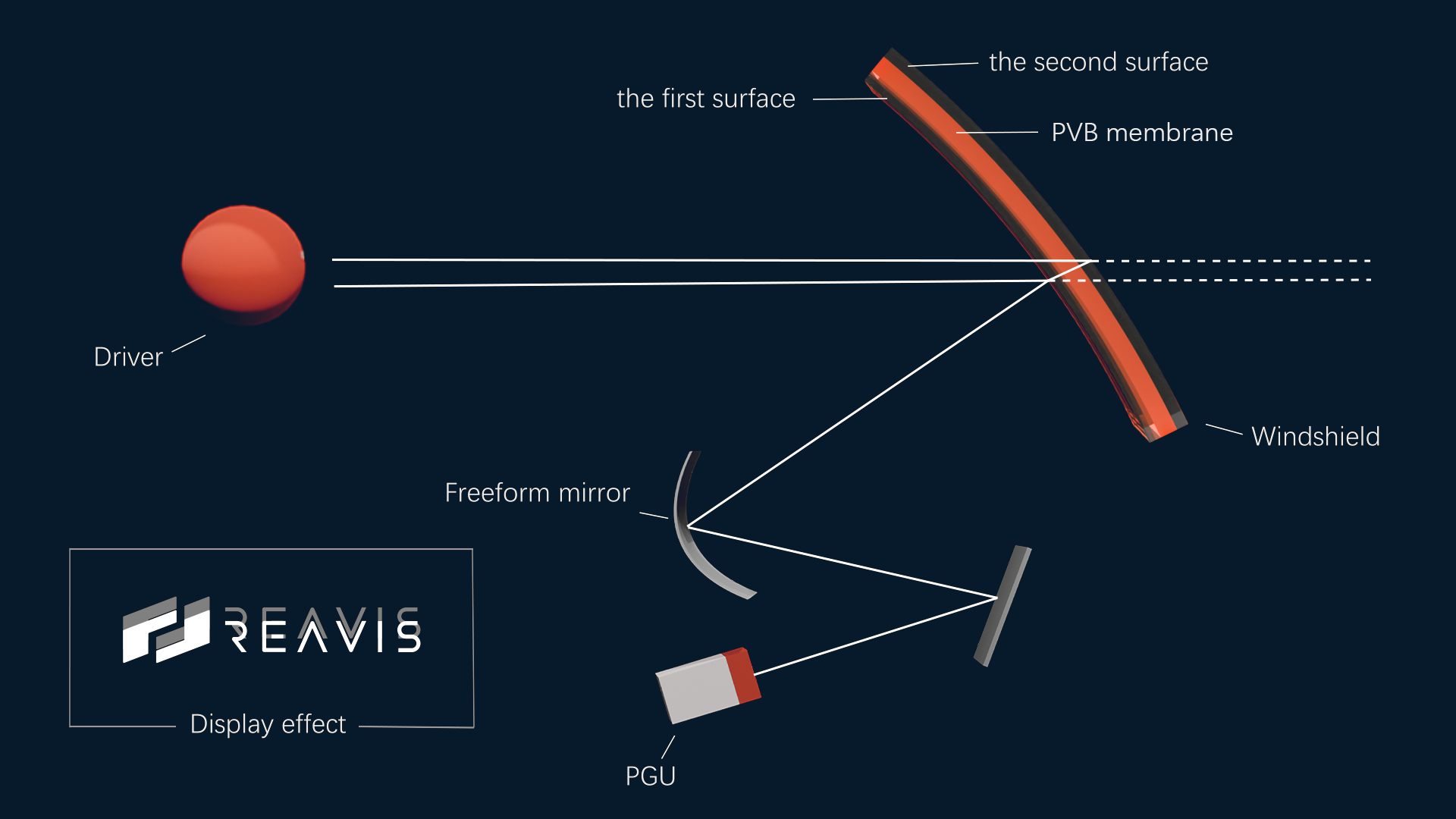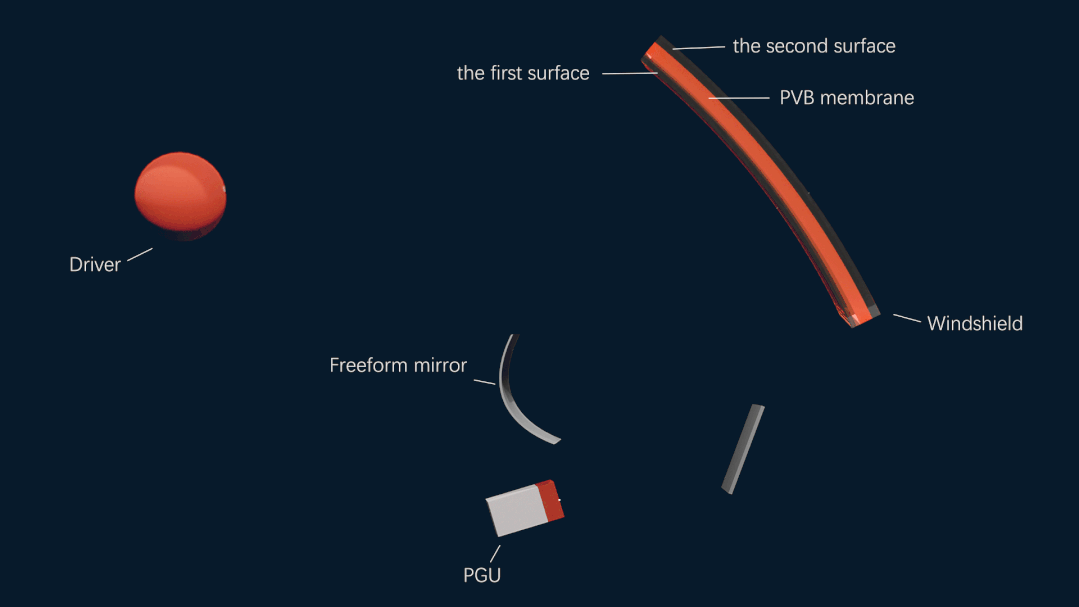Ghost image is a common display phenomenon in HUDs that greatly affects the viewing experience. In this issue, we will introduce the principle behind ghost image and common methods to eliminate it.
Generation of ghost image
HUDs utilize the windshield as a combiner for virtual images and real-world scenes. Light rays from the HUD are reflected off the windshield and into the driver's eyes, allowing them to see the projected virtual image. The windshield has a certain thickness, meaning it has two surfaces. When a beam of light enters at an angle, it undergoes reflection and refraction at the first surface due to the different refractive indices of air and glass. The refracted light then undergoes reflection and refraction again upon reaching the second surface of the glass[1].
As a result, the same incident light beam usually undergoes two reflections on the first and second surfaces of the windshield, and these two reflected rays do not completely overlap. They reach the eye in a staggered manner, forming two images with identical content but offset positions. The image reflected by the first surface of the windshield is the primary image we need, while the image reflected by the second surface is what is commonly referred to as ghost image[2]. ghost image images typically have lower brightness compared to the primary image, and the distance between the primary image and ghost image image (measured in millimeters) or the angular separation between them (measured in minutes or mrad) can be used to evaluate ghost image[3].
The presence of ghost image not only degrades image quality but also causes dizziness, affecting the driving experience of the driver.

Eliminating ghost image with Wedge-shaped PVB Film
To address the issue of ghost image, a common solution is to modify the shape and thickness of the PVB film in the windshield.
The construction of the windshield follows a "sandwich" structure, with a layer of PVB film sandwiched between two layers of glass. The primary role of the PVB film is to enhance the impact resistance of the glass, ensuring that it does not shatter into flying shards upon impact, thereby enhancing the safety of the windshield[4].
The PVB film in a regular windshield typically has a uniform thickness throughout, as shown in Figure (1). One of the most common methods to eliminate ghost image is to reshape this layer of PVB film into a wedge shape: transitioning from the traditional "uniform thickness" to "thicker on top, thinner on bottom," creating a three-dimensional wedge angle[5].
The "thicker on top, thinner on bottom" configuration results in a unique feature of the wedge-shaped PVB film: due to the presence of the wedge angle, the entire sandwich structure of the windshield also exhibits a "thicker on top, thinner on bottom" profile. This means that after the light is refracted off the first surface of the glass and reaches the second surface of the windshield, the height and angle of reflection change accordingly. This alteration causes the two virtual images formed by the light rays at the first and second surfaces to overlap, thereby reducing the phenomenon of ghost image (see Figure (2))[5].

The wedge-shaped film enables drivers to observe clear images and effectively addresses the issue of ghost image. However, this method also has some drawbacks. Firstly, the wedge-shaped film needs to be designed according to the specific vehicle model equipped with HUD. This is because the angle of the wedge-shaped film is related to factors such as the angle of incidence of light and the virtual image projection distance (VID), necessitating consideration of installation position, HUD optics, and windshield design with the wedge-shaped PVB film interlayer[6]. Secondly, complete elimination of ghost image requires precise optical and wedge angles. However, due to accumulated tolerances in the production of windshields, wedge-shaped films, HUDs, and equipment installation, it is not possible to achieve complete overlap between ghost image and the main image, especially at viewing angles deviating from the center of the eye box. Therefore, even with the addition of wedge-shaped films, some degree of ghost image can still be detected when evaluating the final imaging[7]. Hence, the industry typically assesses and evaluates HUDs based on the ghost image rate, aiming to keep it below a reasonable threshold. Lastly, the cost of customized wedge-shaped PVB films is relatively high. Currently, wedge-shaped films are mainly used in passenger cars. For other vehicle types such as commercial vehicles and rail transportation, the cost of wedge-shaped films increases significantly, restricting the expansion and application of HUD technology[7].
Apart from wedge-shaped PVB films, other new methods to eliminate ghost image have emerged in the market, which we will discuss in the next issue.
#Reference:
[1]Born and Wolf. (1959). "Principles of Optics". New York, NY: Pergamon Press INC.
[2]Gao Lei. (2014). "Introductionof Head Up Display (HUD)". China Terminology, 16(zk1): 19-21.
[3]Huang Xingzhou. (2019). "Research on optical module technology of vehicle head-up display system". Chengdu: Institute of Optoelectronic Technology, Chinese Academy of Sciences.
[4]Feng Haigang, Li Lin. (2005). "The history and development prospect of polyvinyl butyral (PVB) film". Foreign Plastics, 23(10): 42-43.
[5]Wang Hu, Quan Yangke, Guo Hongling, et al. (2008). "Research on the identification method of automobile windshield". Criminal Technology, 2008 (2): 6.
[6]Derlofske, John Van, et al. (2019). "Invited Paper: New Optical Films for Next Generation AR Head Up Displays (HUDs)". SID Symposium Digest of Technical Papers. Vol. 50. No. 1.
[7]Van Derlofske J, Pankratz S, Franey E. (2020). "New film technologies to address limitations in vehicle display ecosystems". Journal of the Society for Information Display, 28(12): 917-925.